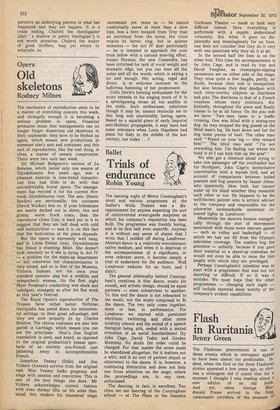Trials of endurance
Robin Young
The opening night of Merce Cunningham's short and various programme at the Sadler's Wells Theatre was a disappointment for anyone expecting the sort of controversial avant-garde surprises on which his company's reputation has been built. The programme was frankly boring, and in its first half even soporific. Anyway it is without any sense of shame that I write that I nodded off during Landrover. Abstract dance is a relatively noncommunicative medium, and when it is deprived of the accompaniment of a significant, or even relevant score, it become simply a trial of endurance for the audience. Well Landrover endures for an hour, and I didn't.
The general philosop'hy behind Cunningham's creations is that dance, music (or sound), and artistic design, should be equal partners — none subservient to another. To this end the dance is not rehearsed to the music, nor the music composed to fit the dance. The two only come together, more or less, in performance. For Landrover we started with persistent electronic twittering and after some scratchy silence and the sound of a speech therapist being sick, ended with a muted evocation of an aerial bombardment (by John Cage, David Tudor and Gordon Mumma). No doubt the order could be changed. For that matter the score could be abandoned altogether, for it matters not a whit, and is no sort of partner (equal or otherwise) to the dance. It is, however, a continuing distraction and does not help one focus attention on the stage, where the proceedings are, in any case, unfocussed.
The dancing, in fact, is excellent. Too often we see dancing of the Cunningham school — at The Place or the Jeanetta Cochrane Theatre — made to look very difficult indeed. Here everything is performed with a supple, understated virtuosity. But when it goes on disjointedly and meaninglessly for an hour, one does not consider that they do it very well: one questions why they do it at all.
In the second half the boot is on the other foot. This time the accompaniment is by John Cage, and is read by him and David Vaughan, as champagne-sipping raconteurs set on either side of the stage. They raise quite a few laughs, partly, no doubt, because their role is unexpected, but also because they deal deadpan with such titter-worthy subjects as diarrhoea and piss. The diarrhoea is that of a French countess whose story continues, disjointedly, throughout the piece and finally ceases to be at all funny. On the piss side we have: 'Two men came to a traffic crossing. One was blind with a seeing-eye dog. As they stopped the dog pissed on the blind man's leg. He bent down and fed the d,og some pieces of beef. The other man said: "Pissed on your leg — why reward him?" The blind man said: "I'm not rewarding him. I'm finding out where his head is so I can kick him up the arse".'
We also get a chestnut about trying to take one passenger off the overloaded bus for Stockport, John Cage's inconclusive conversation with a mynah bird, and an account of comparisons between boiled peanuts and hog peanuts by Jasper Johns, who apparently likes both but cannot make up his mind whether they resemble each other or not. He happens to be the well-known painter who is artistic adviser to the company and responsible for the otherwise unremarkable unisexual coloured tights in Landrover.
Meanwhile the dancers bounce energetically through the sort of movements associated with those more obscure games — such as volley and basketball — of which we had our fill from the Olympic television coverage. The readers hog the attention — unfairly, because if you gave their material to a stand-up comedian he would not even be able to raise the thin laughs with which they are privileged.
Perhaps Cunningham's intention was to start with a programme that was not too daunting or difficult. If so it was a mistake. We must hope that the other programmes — changing each night -will include material more worthy of the company's evident capabilities.










































 Previous page
Previous page